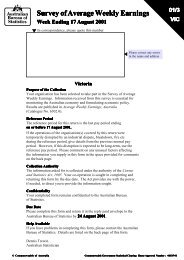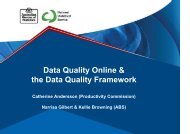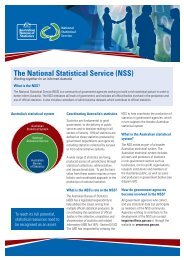SAE Manual Sections 1 to 4_1 (May 06).pdf - National Statistical ...
SAE Manual Sections 1 to 4_1 (May 06).pdf - National Statistical ...
SAE Manual Sections 1 to 4_1 (May 06).pdf - National Statistical ...
You also want an ePaper? Increase the reach of your titles
YUMPU automatically turns print PDFs into web optimized ePapers that Google loves.
A Guide <strong>to</strong> Small Area Estimation - Version 1.1 05/05/20<strong>06</strong><br />
A) What are the key policy making or program funding decisions that<br />
require small area data?<br />
Knowing how the small area data will be used as input <strong>to</strong> user’s decision making process<br />
is essential in ensuring the small area output meets user requirements. User decision<br />
making requirements can vary considerably. Some may be quite sophisticated and<br />
quantitatively based. Others may be quite informal and qualitatively based. In the former<br />
case, the decision making process should be identified and well unders<strong>to</strong>od as inherent<br />
assumptions may help determine just how accurate small area data really needs <strong>to</strong> be. It<br />
is also important <strong>to</strong> ensure, where possible, that the small area data is consistent and<br />
compatible with the users’ decision making process, and that the output of this process<br />
meets user expectations, not just the ABS small area output. A quality assessment should<br />
include measures of the fitness for purpose of small area output.<br />
However many users do not have sophisticated, quantitatively based decision making<br />
processes, and may have difficulty in articulating the very nature of the problem they<br />
wish <strong>to</strong> solve.<br />
Before undertaking the project it is worth investigating whether the small area estimates<br />
requested may suit the needs of a wider range of clients. Quite often similar data is<br />
required by different clients and can be useful for a wide range of users. By incorporating<br />
their needs in<strong>to</strong> the project, this increases the value of the final product with minimal<br />
additional cost.<br />
B) What are the organisation's strategic context, goals and desired<br />
outcomes, in which these decision making requirements are nested?<br />
Need <strong>to</strong> ask users what the data problem is, why data needs <strong>to</strong> be obtained, the decision<br />
making processes used, what the users are trying <strong>to</strong> find out and why. This can be<br />
matched up with what is possible <strong>to</strong> estimate from the available data. Any possible<br />
limitations then can be identified early and additional information can be sought or the<br />
user can be made aware. When the final product is created the user has a good<br />
understanding of the limitations and the product is a close as is possible <strong>to</strong> what they<br />
need.<br />
C) What small area data do users think would best meet their decision<br />
making requirements and what level of geography is required?<br />
A minimum level of information on the variable of interest is needed in each small area.<br />
Given the available data, the user needs <strong>to</strong> be aware that a given level of the quality for<br />
the small area estimates is subject <strong>to</strong> a trade-off between the level of what geographic<br />
level and level of detail in the data is possible <strong>to</strong> model. That is, in the context of<br />
household based collections, a reasonably common characteristic of the variable of<br />
interest (say, greater than 10%) may be estimated at a reasonably fine level of geography<br />
such as <strong>Statistical</strong> Local Area (SLA). However, a variable of interest representing less<br />
than 1% of the population, can only be reliably estimated at a broader level of geography<br />
such as <strong>Statistical</strong> Sub-Division (SSD). For example, in the disability study estimates for<br />
physical disability (which accounts for more than 10%) could be obtained at a reasonably<br />
Australian Bureau of Statistics 11








